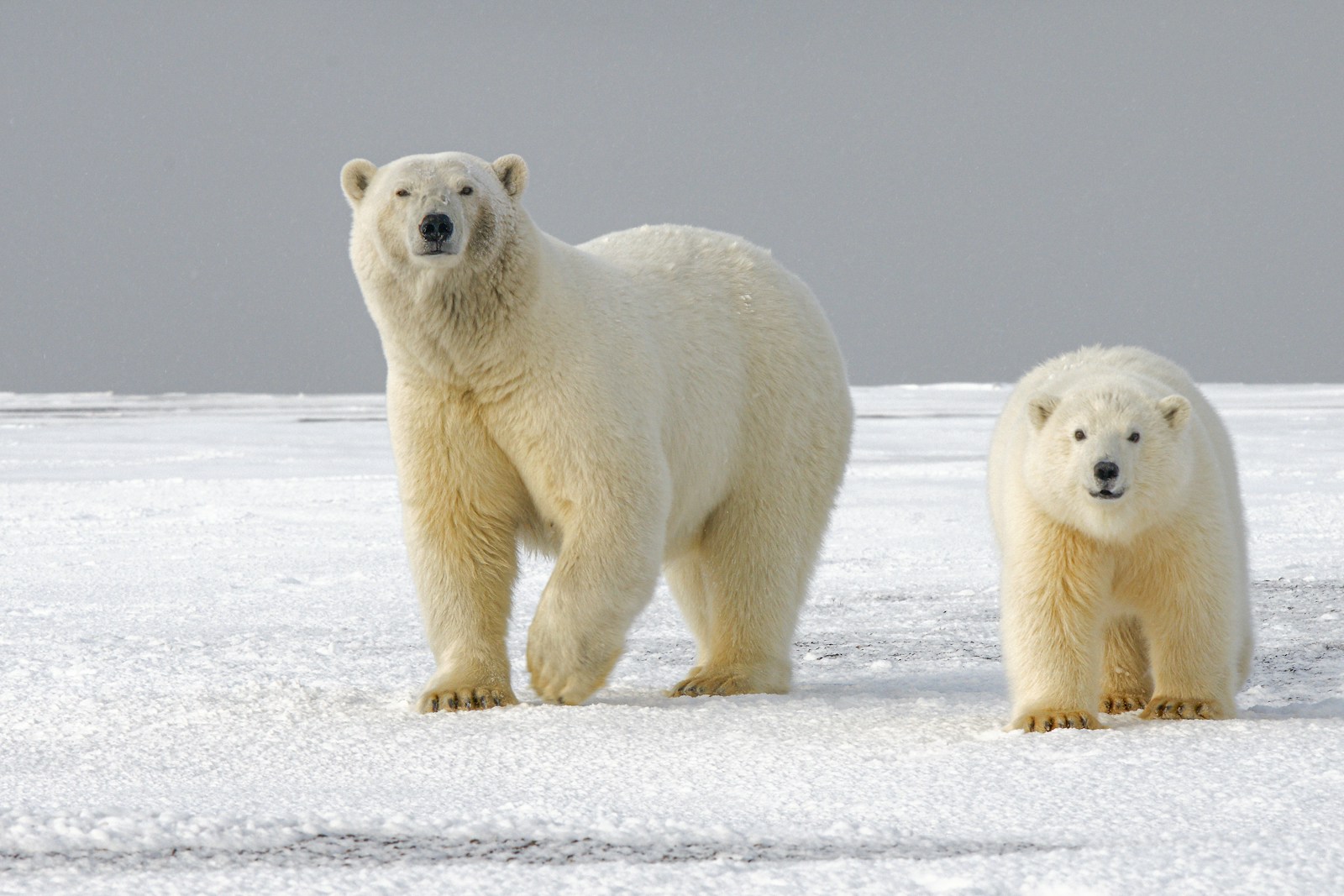Polar bears are magnificent creatures of the Arctic, often admired for their beauty and strength. However, behind their impressive appearance lies a fierce predator. These bears are the largest land carnivores, with a powerful bite force, and they rely heavily on seals and sometimes carrion for their diet. This underscores their predatory nature. But what makes polar bears particularly dangerous to humans is not merely their physical abilities. Their behavior towards humans, driven by curiosity and hunger, can lead to unpredictable and aggressive encounters. While polar bear attacks are rare due to their remote habitats, the potential for danger is high when humans enter their territory. Understanding the risks and respecting their space is essential for coexisting in the icy wilderness they call home.
How Dangerous Are Polar Bears?
| Factor | Danger Level | Explanation |
|---|---|---|
| Inherent Aggression | Low | Polar bears are not naturally aggressive towards humans. They are apex predators, but their main prey are seals. |
| Risk of Attack | Increases with Limited Food | Due to climate change affecting their sea ice habitat, polar bears may be coming into closer contact with humans while searching for food. Hunger can make them more likely to see humans as prey. |
| Severity of Attack | Very High | Polar bears are the largest land predator on Earth. An attack from a polar bear is extremely dangerous and can be fatal. |
| Frequency of Attacks | Rare | Attacks on humans are uncommon, but there have been documented fatalities. |
Additional Considerations
- Human Behavior: Maintaining a safe distance, avoiding attracting bears with food or trash, and following proper protocols in polar bear country can significantly reduce the risk of encounters.
- Climate Change: As the Arctic sea ice continues to melt, interactions between polar bears and humans are likely to become more frequent.
Overall
Polar bears are majestic creatures, but they are also wild animals. Respect their power and avoid situations where conflict could arise.

Photo by Leon Aschemann on Pexels
Key Takeaways
- Polar bears, the largest land carnivores, exhibit formidable physical capabilities and a predatory nature, primarily feeding on seals but can pose a risk to humans when searching for food.
- The melting of Arctic sea ice due to climate change is challenging polar bear survival, forcing them to travel longer distances for food and occasionally closer to human settlements, increasing encounters.
- Polar bear encounters with humans, though rare, can be dangerous. Communities in polar bear territories employ strategies such as bear patrols and bear-proof food storage to minimize risks.
- Coexistence between humans and polar bears requires understanding and mitigating behavioral threats through precautions, education, and community-level safety measures aimed at reducing the likelihood of dangerous interactions.
Overview of Polar Bears
Polar bears are mighty creatures living in the Arctic. They are the largest land carnivores, which means they mainly eat meat. Their fur looks white but is actually clear and hollow. This helps them blend in with the snow and ice. Underneath their fur, their skin is black to soak up the sun’s warmth.
These bears depend on sea ice to hunt their main food, seals. They wait by holes in the ice to catch seals coming up for air. But, as the climate changes, sea ice is melting. This makes it harder for polar bears to find food. They need lots of fat from seals to stay healthy and strong.
Polar bears are usually found alone, except for mothers with their cubs or when gathering to find food. They can swim long distances, using their large front paws like paddles. Despite their size, they are fast runners on short distances.
Because of food shortages, polar bears might come closer to human areas, searching for something to eat. While not naturally aggressive towards humans, hungry bears can pose a risk. Attacks are rare but can happen. This is why it’s important to be careful around their habitats.
Scientists study these bears to understand how to protect them and people living near them. By tracking their health and movements, experts hope to reduce the chances of bear-human encounters. Protecting polar bears is critical for their survival and the Arctic ecosystem.
Physical Characteristics and Abilities
Polar bears stand out as the largest land carnivores, their size and physical features directly impacting their hunting skills and overall survival. Adult polar bears can weigh over 1,700 pounds and reach 10 feet in height when standing on their hind legs. This immense size grants them extraordinary strength, crucial in their harsh Arctic habitat.
Their fur, thick and white, offers not just camouflage against the snow and ice but also insulation. Beneath the fur, a layer of fat up to 4 inches thick adds another level of warmth, essential for surviving the frigid temperatures. Polar bears have large front paws with webbed toes, aiding in swimming. These bears are remarkable swimmers, capable of covering miles in search of food.
The claws of a polar bear, nearly four inches long, combined with their powerful jaws and long, sharp canines, make them formidable hunters. Their diet mainly consists of seals, which they catch using stealth and strength. Polar bears have a highly developed sense of smell, enabling them to detect seals nearly a mile away and beneath several feet of compacted snow and ice.
However, their specialized skills and adaptations don’t just underscore their prowess but also highlight their vulnerability to the changing climate. The melting of sea ice, crucial for hunting, poses a significant threat to their survival. As the ice shrinks, polar bears are forced to adapt to longer swimming distances and scarce food supplies, leading them to venture closer to human settlements in search of food.
These physical traits and abilities paint a picture of a creature perfectly adapted to its environment, yet facing unprecedented challenges. Polar bears’ interactions with their surroundings offer invaluable insights into the impacts of environmental changes on Arctic wildlife.
Predatory Nature and Diet
Polar bears are top predators in the Arctic. They mainly eat seals which provide them with fat they need to survive. Polar bears have powerful bodies. They can weigh over 1,200 pounds and use their strength to hunt. Their large paws help them swim long distances in cold waters to find food.
These animals have a strong sense of smell. They can detect a seal from miles away. During the colder months, polar bears use sea ice as a platform to catch seals. They wait by holes in the ice, ready to pounce when a seal comes up for air.
When sea ice melts in the summer, hunting becomes harder. Some polar bears then look for other food sources like birds’ eggs or small mammals. Though, these foods don’t give as much energy as seals. This change affects their health and ability to survive.
Due to their size and strength, polar bears don’t have natural enemies. But their interactions with humans can be dangerous. They may approach human settlements when searching for food. It’s rare, but they can attack if they feel threatened or if they’re very hungry.
Their diet and hunting methods showcase their adaptability. But with changing climate and melting sea ice, polar bears face big challenges. They’re traveling longer distances to find food which puts them under stress. This highlights the need to protect Arctic environments to help these incredible animals thrive.
Behavioral Threats to Humans
Polar bears, known for their immense size and strength, pose a real risk to human safety in areas where their habitats overlap with human settlements. These majestic creatures, the largest land carnivores on Earth, can stand over 10 feet tall and weigh more than 1,700 pounds. Their physical prowess isn’t just for show. With claws nearly four inches long and a bite force of 1,200 psi, polar bears are formidable predators.
Humans aren’t typically on the menu for polar bears, but conflicts can arise when bears search for food. As the Arctic ice melts, polar bears are forced to roam further in search of seals, their primary food source. This search for sustenance occasionally leads them closer to human dwellings. Here, they may come across trash bins, stored food, or other potential food sources, increasing the likelihood of encounters with people.
These encounters are not to be taken lightly. Polar bears are curious and may approach people or enter camps and settlements. While attacks on humans are rare, they are serious when they occur. In most cases, bears are looking for food rather than seeing humans as prey. This does not reduce the danger, however. People living in and visiting polar bear territories are advised to take precautions, such as securing food, avoiding areas bears frequent, and making noise while moving to avoid surprising a bear.
Communities have developed strategies to coexist with polar bears. These include using polar bear patrols, creating bear-proof storage for food, and educating residents and visitors on how to minimize risks. While these measures do not eliminate the possibility of an encounter, they significantly reduce the likelihood of a dangerous interaction.
Polar bears’ behavior towards humans is shaped by their need to survive in a changing Arctic. As their habitat continues to diminish, understanding and mitigating these behavioral threats becomes more critical.
Mitigating Risks and Coexistence
When it comes to polar bears and humans living close by, safety is a big deal. Polar bears might not see humans as food, but when they’re searching for a meal, they can wind up too close for comfort. Keeping both bears and people safe means taking steps to lower the chance of run-ins.
One of the smart moves communities can make is setting up polar bear patrols. These teams keep an eye out for bears that might enter towns or villages. They use tools like spotlights, vehicles, or even loud noises to gently push the bears back towards their natural habitat. This helps to avoid surprises for both humans and bears.
Another key strategy involves bear-proofing food storage. Polar bears have a strong sense of smell and can get drawn to food from far away. By using secure containers and keeping food out of reach, towns can make themselves a lot less interesting to a hungry bear. This isn’t just for trash but also for things like pet food or any outdoor storage that might smell appealing.
Education plays a huge role, too. People living in areas where polar bears might show up need to know how to behave to reduce risks. This could include community workshops, informative signs, and clear instructions on what to do in case of an encounter. The idea is to make sure everyone’s on the same page about not attracting bears into town areas.
There’s also a push for research and monitoring. Scientists and local governments work together to keep track of polar bear movements. By understanding where bears are likely to go, communities can be better prepared. This might involve adjusting patrol routes, sending out warnings, or even temporarily closing certain outdoor areas.
These methods are not just about keeping people safe; they’re about respecting polar bears. With the right strategies, we can live in close proximity without causing harm to either side.
Conclusion
Understanding and respecting the natural behaviors of polar bears is key to minimizing risks in areas where humans and these majestic creatures coexist. By implementing effective safety measures such as polar bear patrols and bear-proof food storage alongside continuous education, communities can significantly reduce the likelihood of dangerous encounters. Research and monitoring play a pivotal role in adapting to the movements of polar bears ensuring both human and bear safety. These efforts not only protect individuals but also demonstrate a commitment to preserving the delicate balance between humans and wildlife in the Arctic. Through such proactive approaches, peaceful coexistence with polar bears is not just a possibility but a reality.
Frequently Asked Questions
Is a polar bear more dangerous than a grizzly?
Polar bears are generally less aggressive towards humans than grizzly bears. However, they are larger and stronger, which could make them more dangerous in a direct confrontation. Grizzly bears, on the other hand, are more accustomed to encountering humans and may exhibit more aggressive behavior.
What is the most dangerous animal?
The mosquito is the deadliest animal to humans, responsible for approximately 780,000 deaths annually. Its danger lies in its ability to spread diseases like malaria, dengue fever, Zika virus, and West Nile virus.
What is a polar bear’s worst enemy?
Humans are considered the greatest threat to polar bears due to hunting and habitat destruction. While polar bears have no natural predators, human activities have significantly impacted their survival.
What is the most aggressive bear species?
Sloth bears, Asiatic black bears, and brown bears are known for being more aggressive towards humans compared to other species. The American black bear is generally less aggressive and more timid in comparison.
What makes polar bears so dangerous?
Polar bears can reach sizes up to 10 feet tall and weigh over 1700 pounds, with nearly four-inch long claws and a bite force of 1,200 psi. Their physical capabilities, combined with sharp canines and molars specialized for their Arctic diet, make them formidable predators.







